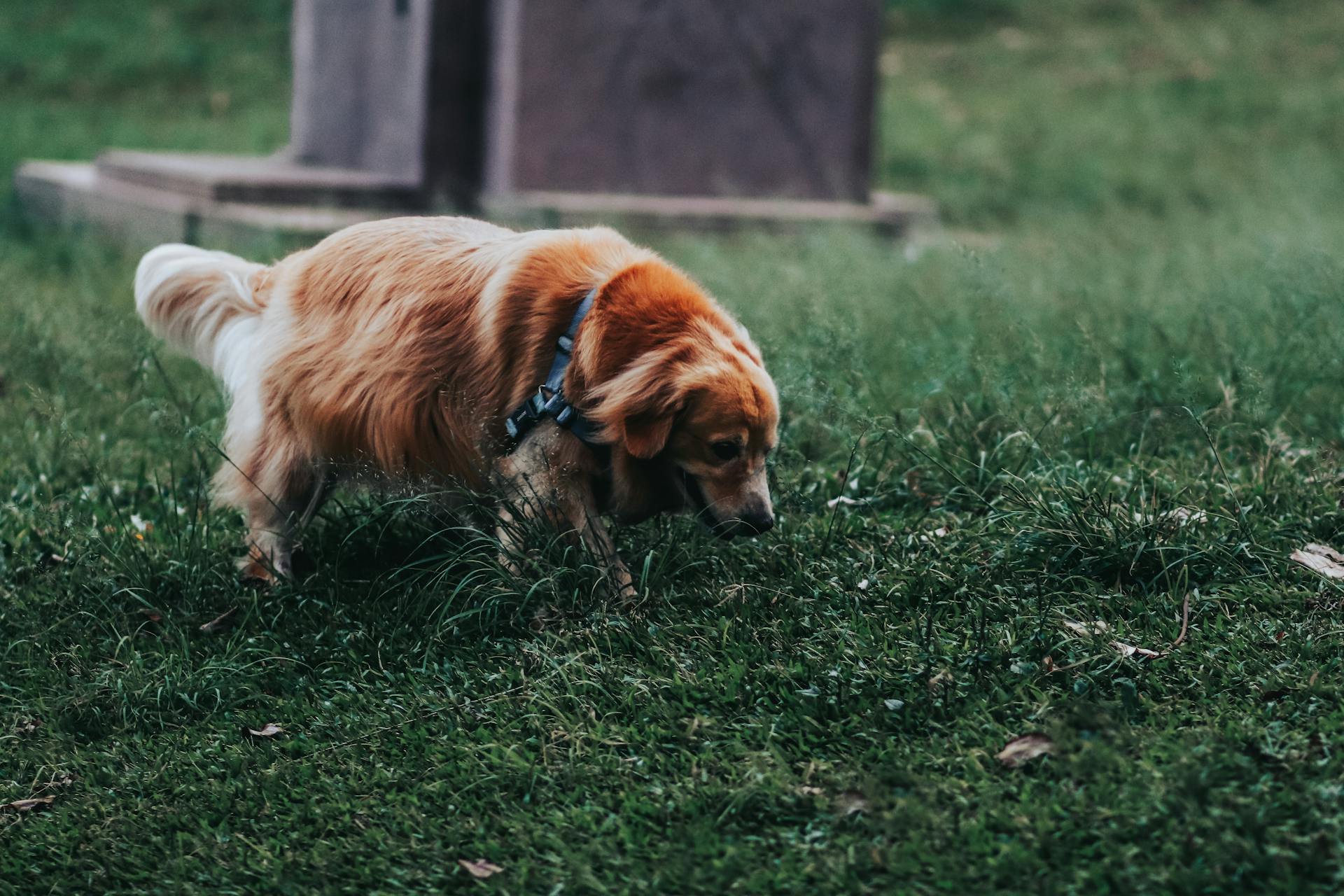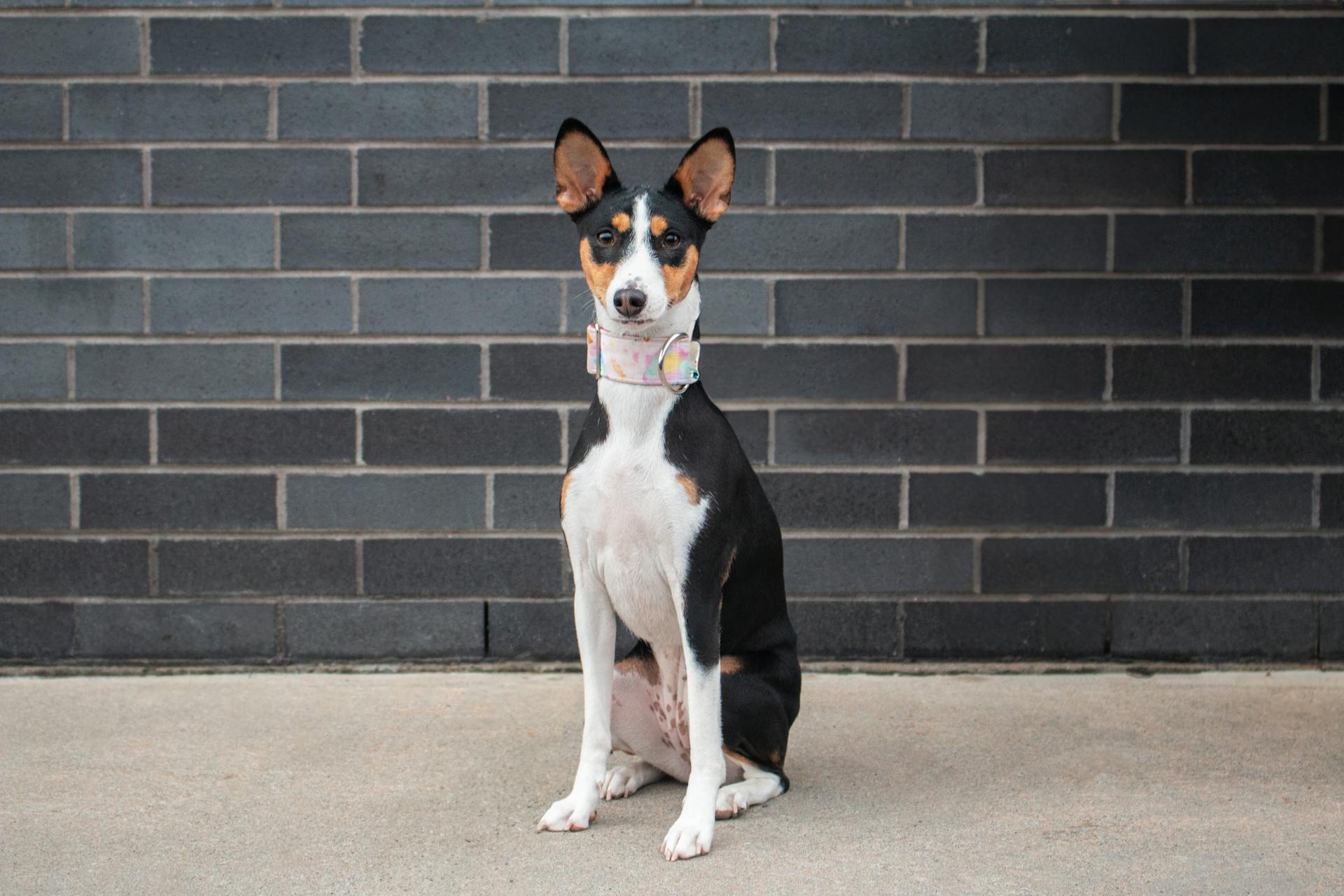
Great Pyrenees are known for their independent nature, which can sometimes lead to behavior problems if not addressed properly.
They have a strong instinct to guard and protect their territory, which can result in aggression towards other animals or people.
To prevent these behavior problems, it's essential to establish a strong bond with your Great Pyrenees through consistent training and socialization from an early age.
Regular exercise and mental stimulation can also help to channel their energy and reduce the likelihood of destructive behavior.
Great Pyrenees are intelligent dogs that respond well to positive reinforcement training methods, such as clicker training and reward-based learning.
Related reading: Dog Training Stop Biting
Great Pyrenees Behavior
Great Pyrenees dogs don't have a strong drive for chasing, but they are known to bark to alert their family.
They need a sturdy fence to keep them from roaming too far and becoming lost, so make sure to give them a secure outdoor space.
Great Pyrenees value their alone time and may need a space where they can retreat from other pets, especially if they're more playful.
On a similar theme: Great Pyrenees Exercise
They live well with other pets, but it's essential to respect their need for alone time to prevent stress and anxiety.
Great Pyrenees are calm, independent, and alert, making them suitable for families with children who understand how to interact with dogs gently.
However, their large size means they may accidentally bump into smaller children, so it's crucial to supervise interactions closely.
In homes with smaller children, it's best to consider alternative dog breeds that are more suitable for families with young kids.
Training and Commands
Training your Great Pyrenees to respond to certain commands can be a game-changer in addressing common behavior problems. Teaching your dog to "leave it" is essential in preventing resource guarding incidents.
To teach your Great Pyrenees the "leave it" command, hold a treat in your closed hand and present it to your dog. When your dog sniffs or paws at your hand, say "leave it" and once they stop trying to get the treat, praise them and reward them with a treat from your other hand.
You can also use the "drop it" or "give" commands to manage resource guarding. This involves starting with a toy your dog likes but doesn't typically guard, saying "drop it" or "give" while offering a high-value treat, and praising your dog when they release the toy and giving them the treat.
To progress, gradually use the commands with more valuable items, such as toys or food bowls. Consistently using these commands can help prevent resource guarding incidents before they escalate.
Explore further: Do Toy Poodles Bark a Lot
#1 Motivate Your Dog to Learn
To motivate your dog to learn, it's essential to use positive reinforcement techniques. This means rewarding your dog with treats, praise, and affection when they perform a desired behavior.
Start by using high-value treats that your dog loves, as seen in the "Drop It" or "Give" command training. These treats can be used to lure your dog into releasing an item from their mouth.
Praise your dog immediately after they perform the desired behavior, as this helps to associate the action with the reward. For example, when your dog releases a toy, praise them and give them the treat.
Here's an interesting read: Dog Bites Fingers When Taking Treats
Gradually increase the difficulty of the task by using more valuable items, such as toys or food bowls, as you progress with the "Leave It" command training.
Here's a quick rundown of the rewards you can use to motivate your dog:
- High-value treats
- Praise and affection
- Gradually increasing the difficulty of the task
LGds Are Not
LGDs are not high-energy dogs that require constant exercise. They are a relatively low-maintenance breed.
LGDs are bred to work independently, guarding livestock and property with minimal human interaction. This means they are perfectly happy with a daily walk and playtime.
LGDs are naturally suspicious of strangers, but they are not aggressive by nature. They will defend their territory and family if necessary, but they are not prone to attacking without provocation.
In fact, LGDs are often used as therapy dogs because of their calm and gentle nature. They make great companions for families with children.
LGDs are highly intelligent and trainable, but they can be stubborn at times. Consistent training and positive reinforcement are key to developing good behavior.
Suggestion: Dog Won't Eat after Boarding
Resource Guarding
Resource Guarding is a common behavior problem in Great Pyrenees, where they become protective of their food, toys, or other resources. This behavior can be triggered by various factors, including the presence of other dogs or pets, approach of family members, especially children, and sudden movements or loud noises near the guarded resource.
To manage resource guarding, it's essential to understand what's triggering the behavior. This involves observing your Great Pyrenees closely and taking note of which resources they guard and under what circumstances. By identifying the triggers, you can take steps to prevent incidents before they occur.
Desensitization and counter-conditioning are powerful techniques to help your Great Pyrenees overcome resource guarding. Desensitization involves gradually exposing your dog to the triggering situations, starting with low-intensity encounters and gradually increasing the intensity. Counter-conditioning, on the other hand, involves teaching your dog to associate the presence of the trigger with positive experiences.
Here are some common triggers to watch out for:
- The presence of other dogs or pets
- Approach of family members, especially children
- Sudden movements or loud noises near the guarded resource
Identify Resource Guarding Triggers
Your Great Pyrenees guards specific resources, and it's essential to know what triggers this behavior. The presence of other dogs or pets can be a common trigger.
If you notice your Great Pyrenees guarding their food or toys, it's likely due to the presence of other dogs or pets. Approach of family members, especially children, can also be a trigger.
Sudden movements or loud noises near the guarded resource can cause your Great Pyrenees to become protective. Observe your Great Pyrenees closely to identify specific triggers.
Here are some common triggers to look out for:
- The presence of other dogs or pets
- Approach of family members, especially children
- Sudden movements or loud noises near the guarded resource
Resource Guarding Desensitization and Counter-Conditioning
Desensitization and counter-conditioning are powerful techniques to help your Great Pyrenees overcome resource guarding. This approach involves gradually exposing your dog to the triggering situations, starting with low-intensity encounters and gradually increasing the intensity.
Common triggers for resource guarding include the presence of other dogs or pets, approach of family members, especially children, and sudden movements or loud noises near the guarded resource. Understanding these triggers is crucial to managing the environment effectively.
Additional reading: Is Resource Guarding Dangerous
To desensitize your Great Pyrenees, start by standing a considerable distance away while they eat, and gradually decrease the distance over time, rewarding your dog with praise or treats when they remain calm. This process helps your dog associate your presence near their food with positive outcomes, reducing their need to guard the resource.
Desensitization and counter-conditioning can be a game-changer for addressing resource guarding. By teaching your dog to associate the presence of triggers with positive experiences, you can help them feel more comfortable and confident in your presence.
Here are some common triggers for resource guarding, along with some tips for managing them:
- The presence of other dogs or pets: Try to limit interactions between your Great Pyrenees and other animals, especially when they're eating or in possession of a valuable resource.
- Approach of family members, especially children: Teach children to approach your Great Pyrenees calmly and gently, and to avoid sudden movements or loud noises near the guarded resource.
- Sudden movements or loud noises near the guarded resource: Try to minimize sudden movements or loud noises near your Great Pyrenees when they're eating or in possession of a valuable resource.
Preventing Problems
To prevent problems with your Great Pyrenees, it's essential to keep them within an area enclosed by a sturdy fence to prevent them from roaming too far and becoming lost. They enjoy roaming outside, but this can be a challenge if they get loose.
Great Pyrenees value their alone time and may need a space where they can retreat from other pets. This is especially important if you have other playful companions that might get too rambunctious.
A table of signs to watch out for can help you identify potential problems early on:
Consistency and positive reinforcement are key when working with a Great Pyrenees, especially when it comes to addressing resource-guarding behaviors. By rewarding your dog for desired behaviors, you can help them learn to share resources and live a happier, healthier life.
Behavior Tips
Great Pyrenees are not highly active dogs, but they do enjoy roaming outside, so make sure to keep them in a securely fenced area to prevent them from getting lost.
To prevent them from roaming too far, a sturdy fence is a must.
Great Pyrenees are known to bark to alert their family, even if it's just the mail carrier, so be prepared for some barking.
They value their alone time, so make sure to give them a space where they can retreat when needed.
Resource guarding can be a problem with Great Pyrenees, but punishing them for it only makes it worse.
Consider reading: Why Do Great Pyrenees Bark so Much
Instead, focus on positive reinforcement and reward-based training to modify their behavior.
Consistency and patience are key when working with a Great Pyrenees that displays resource guarding behaviors.
As independent dogs, Great Pyrenees can be challenging to train, but enrolling them in obedience classes can be a big help.
Early socialization is also crucial to help them become well-mannered and comfortable in new situations.
Three Signs Your...
Recognizing the signs of resource guarding is crucial in preventing problems with your Great Pyrenees.
Growling or snarling is often the first sign that your Great Pyrenees is resource guarding. If they growl or snarl when someone approaches their food or toys, it's a clear indication that they're trying to protect their resources.
A stiff body language is another common sign of resource guarding in Great Pyrenees. They may stand over their food or toys to prevent others from getting too close.
In extreme cases, a Great Pyrenees that is resource guarding may resort to biting or attacking people or other animals that come too close to their possessions.
Here are the three signs of resource guarding to look out for:
- Growling or snarling
- Stiff body language
- Aggression
Frequently Asked Questions
What are the cons of owning a Great Pyrenees?
Owning a Great Pyrenees comes with challenges, including high shedding and frequent grooming needs, as well as potential difficulties with training and excessive barking. If you're considering bringing one home, be prepared for a loyal companion that requires extra attention and care.
Can Great Pyrenees become aggressive?
Great Pyrenees can become aggressive if trained with punishment or aggression, leading to fear-based aggression. Positive training and education through Recallers can help prevent this and set your dog up for success.
Sources
- https://www.petmd.com/dog/breeds/great-pyrenees
- https://www.forloveoflivestock.com/blog/great-pyrenees-wont-listen
- https://www.embracepetinsurance.com/dog-breeds/great-pyrenees
- https://itsdogornothing.com/does-positive-reinforcement-work-for-great-pyrenees/
- https://iheartdogs.com/7-strategies-to-stop-your-great-pyrenees-resource-guarding/
Featured Images: pexels.com


